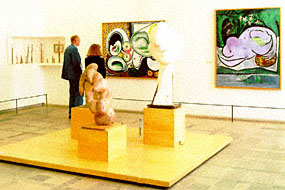The collection was started with the
works that the French State
received in payment of death duties after Picasso passed away in 1973.
Later after the death of his widow, it was bequest with 251 paintings,
160 sculptures, 16 collages, 29 relief paintings, 107 ceramics, 1,500
drawings, 58 notebooks, and his entire engraving works complete with
the various stages of each plate and illustration. Over 100,000 archive
items, photographs, letters, manuscripts and documents make this the
largest and most comprehensive collection of
Picasso's life and work in the world.
 Early Paintings
Early Paintings
The collection is presented in chronological order. It begins on the
first floor with Picasso's early paintings he produced during his first
stays in Paris, among which are: "Self-Portrait" (1901), a masterpiece
of the blue period "Celestina" (1904) and "Self-Portrait" (1906).
Cubism
The Cubist rooms hold paintings such as "Still-Life with Chair-Caning
" (1912), collages, assemblages, fragile constructions and the "Head of
a Woman" (Fernande), and a powerful bronze sculpture (1909).
Classical
The classical works include the paintings, "Portrait of Olga in an
Armchair" (1917), "The Pipes of Pan" (1923) and numerous drawings and
projects for sets and costumes used for the Russian ballet.
Surrealist
Surrealist works, such as "The Kiss" (1925) and "The Crucifixion"
(1930) are also owned by the museum.
Sculpture
The field of sculpture is dominated by the series, Monumental Heads,
executed in Boisgeloup during 1931. The austere still-lifes of the war
period, the sculptures and ceramics from his stay at Vallauris at the
beginning of the 1950s, are grouped together in the vaulted rooms in
the basement.
Last Period
The works of the last period, including "The Seated Old Man"
(1970-1971), bring the tour of the museum to an end on the ground floor.
Picasso's Private Collection
Added to this is Picasso's personal art collection which was donated to
the Louvre in 1993 comprised of African and Oceanic art, Iberian
statuettes, the graphic works of Chardin, Corot, Courbet,
Cézanne, Renoir, Braque, Miro, Matisse, Derain, Balthus and le
Douanier Rousseau.

